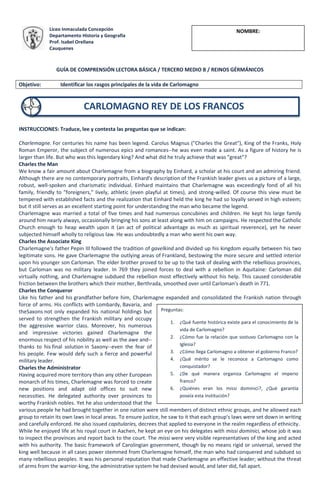
Charlemagne
- 1. Liceo Inmaculada Concepción NOMBRE: Departamento Historia y Geografía Prof. Isabel Orellana Cauquenes GUÍA DE COMPRENSIÓN LECTORA BÁSICA / TERCERO MEDIO B / REINOS GÉRMÁNICOS Objetivo: Identificar los rasgos principales de la vida de Carlomagno CARLOMAGNO REY DE LOS FRANCOS INSTRUCCIONES: Traduce, lee y contesta las preguntas que se indican: Charlemagne. For centuries his name has been legend. Carolus Magnus ("Charles the Great"), King of the Franks, Holy Roman Emperor, the subject of numerous epics and romances--he was even made a saint. As a figure of history he is larger than life. But who was this legendary king? And what did he truly achieve that was "great"? Charles the Man We know a fair amount about Charlemagne from a biography by Einhard, a scholar at his court and an admiring friend. Although there are no contemporary portraits, Einhard's description of the Frankish leader gives us a picture of a large, robust, well-spoken and charismatic individual. Einhard maintains that Charlemagne was exceedingly fond of all his family, friendly to "foreigners," lively, athletic (even playful at times), and strong-willed. Of course this view must be tempered with established facts and the realization that Einhard held the king he had so loyally served in high esteem; but it still serves as an excellent starting point for understanding the man who became the legend. Charlemagne was married a total of five times and had numerous concubines and children. He kept his large family around him nearly always, occasionally bringing his sons at least along with him on campaigns. He respected the Catholic Church enough to heap wealth upon it (an act of political advantage as much as spiritual reverence), yet he never subjected himself wholly to religious law. He was undoubtedly a man who went his own way. Charles the Associate King Charlemagne's father Pepin III followed the tradition of gavelkind and divided up his kingdom equally between his two legitimate sons. He gave Charlemagne the outlying areas of Frankland, bestowing the more secure and settled interior upon his younger son Carloman. The elder brother proved to be up to the task of dealing with the rebellious provinces, but Carloman was no military leader. In 769 they joined forces to deal with a rebellion in Aquitaine: Carloman did virtually nothing, and Charlemagne subdued the rebellion most effectively without his help. This caused considerable friction between the brothers which their mother, Berthrada, smoothed over until Carloman's death in 771. Charles the Conqueror Like his father and his grandfather before him, Charlemagne expanded and consolidated the Frankish nation through force of arms. His conflicts with Lombardy, Bavaria, and theSaxons not only expanded his national holdings but Preguntas: served to strengthen the Frankish military and occupy 1. ¿Qué fuente histórica existe para el conocimiento de la the aggressive warrior class. Moreover, his numerous vida de Carlomagno? and impressive victories gained Charlemagne the 2. ¿Cómo fue la relación que sostuvo Carlomagno con la enormous respect of his nobility as well as the awe and-- thanks to his final solution in Saxony--even the fear of Iglesia? his people. Few would defy such a fierce and powerful 3. ¿Cómo llega Carlomagno a obtener el gobierno Franco? military leader. 4. ¿Qué mérito se le reconoce a Carlomagno como Charles the Administrator conquistador? Having acquired more territory than any other European 5. ¿De qué manera organiza Carlomagno el imperio monarch of his times, Charlemagne was forced to create franco? new positions and adapt old offices to suit new 6. ¿Quiénes eran los missi dominici?, ¿Qué garantía necessities. He delegated authority over provinces to poseía esta institución? worthy Frankish nobles. Yet he also understood that the various people he had brought together in one nation were still members of distinct ethnic groups, and he allowed each group to retain its own laws in local areas. To ensure justice, he saw to it that each group's laws were set down in writing and carefully enforced. He also issued capitularies, decrees that applied to everyone in the realm regardless of ethnicity. While he enjoyed life at his royal court in Aachen, he kept an eye on his delegates with missi dominici, whose job it was to inspect the provinces and report back to the court. The missi were very visible representatives of the king and acted with his authority. The basic framework of Carolingian government, though by no means rigid or universal, served the king well because in all cases power stemmed from Charlemagne himself, the man who had conquered and subdued so many rebellious peoples. It was his personal reputation that made Charlemagne an effective leader; without the threat of arms from the warrior-king, the administrative system he had devised would, and later did, fall apart.
